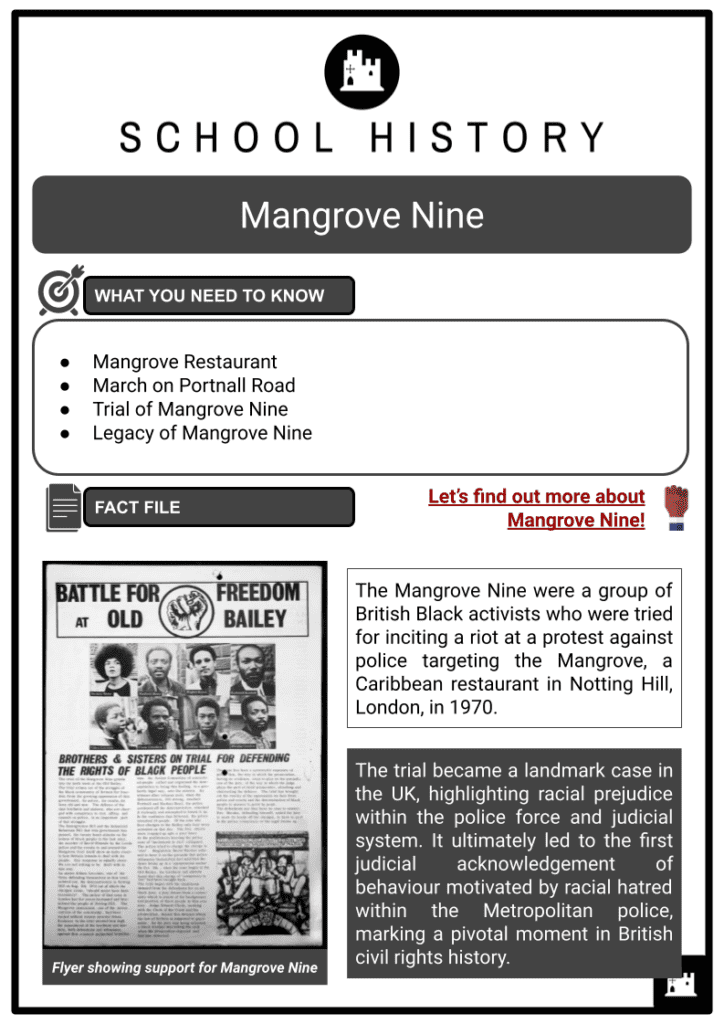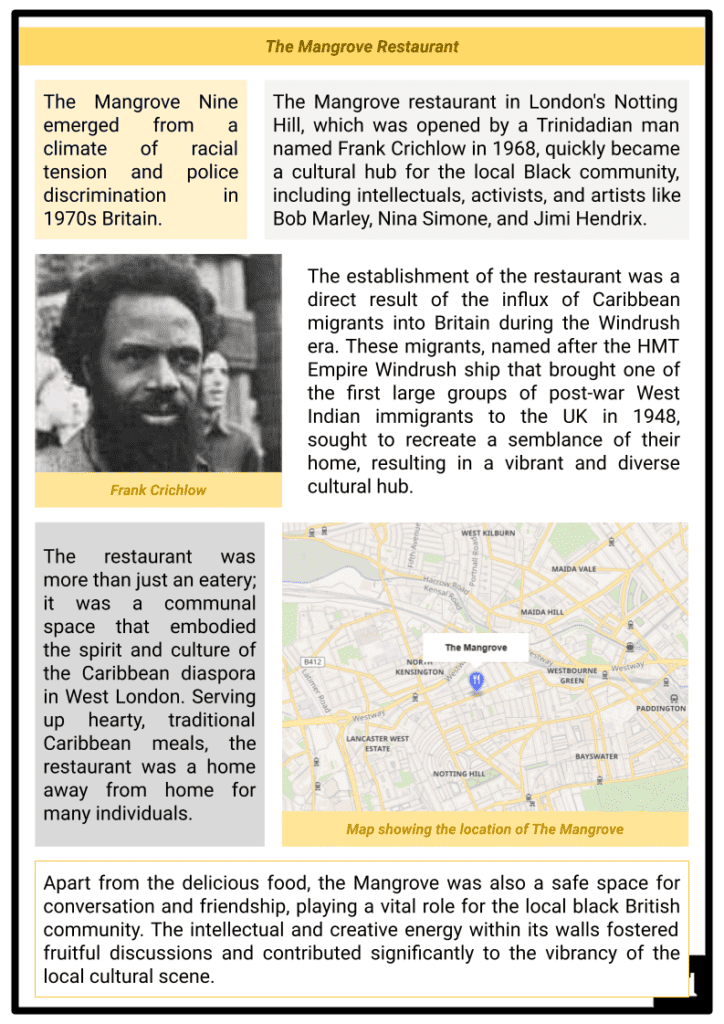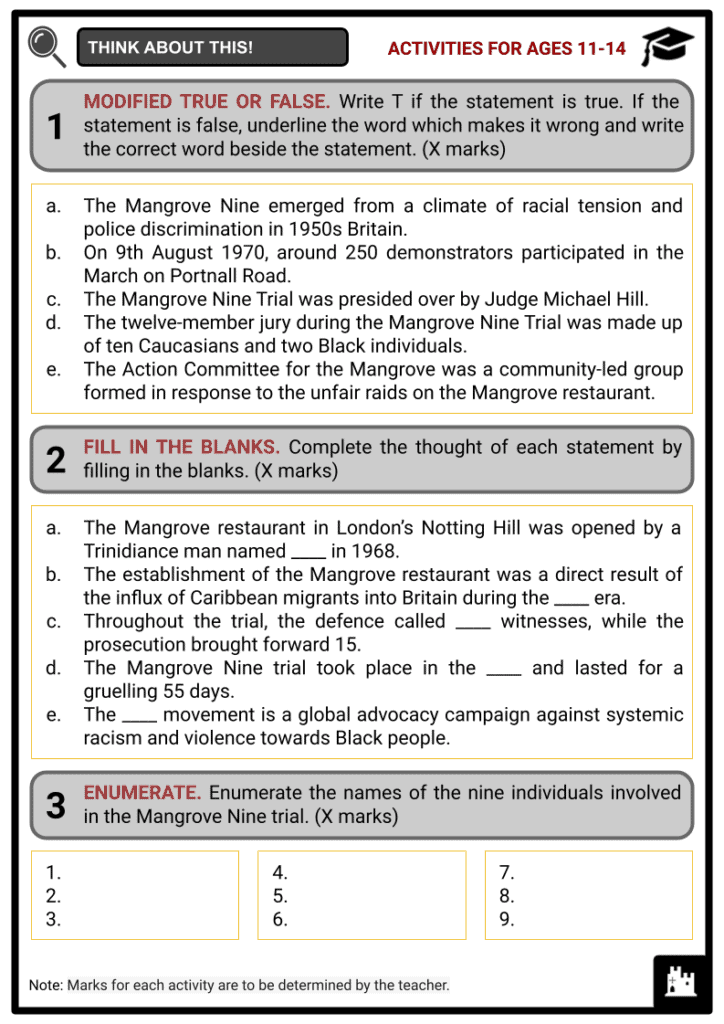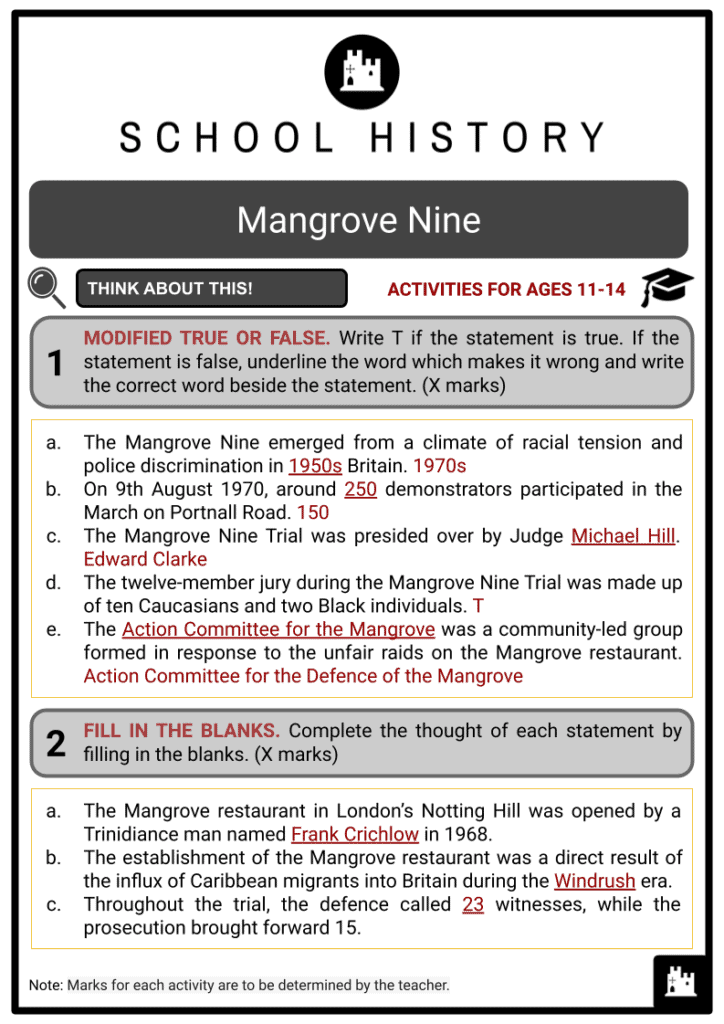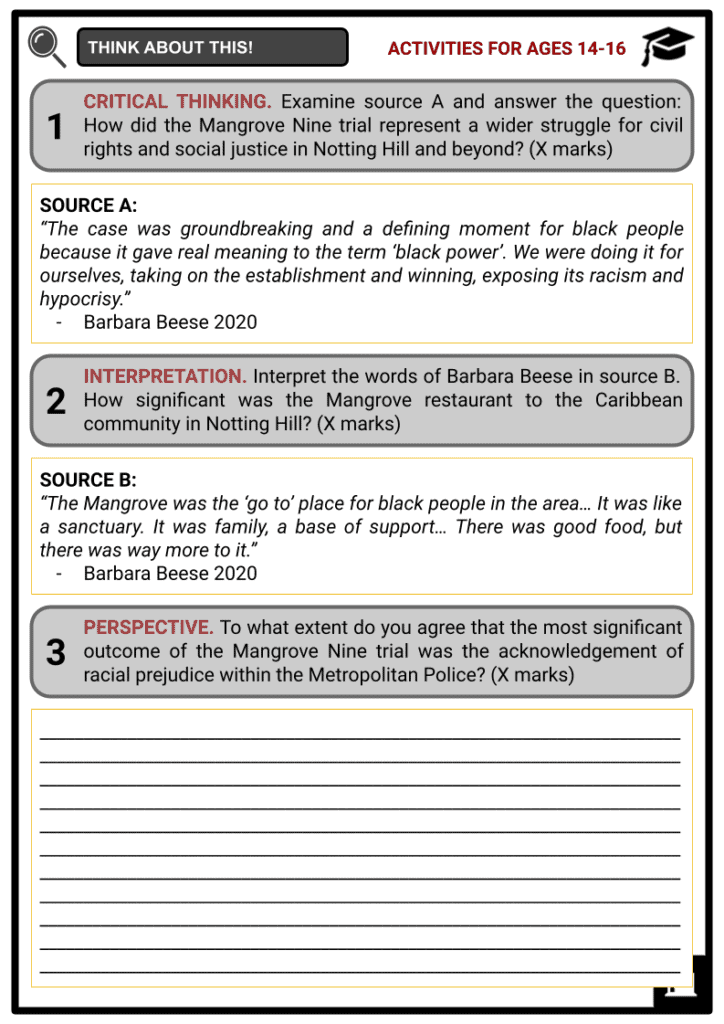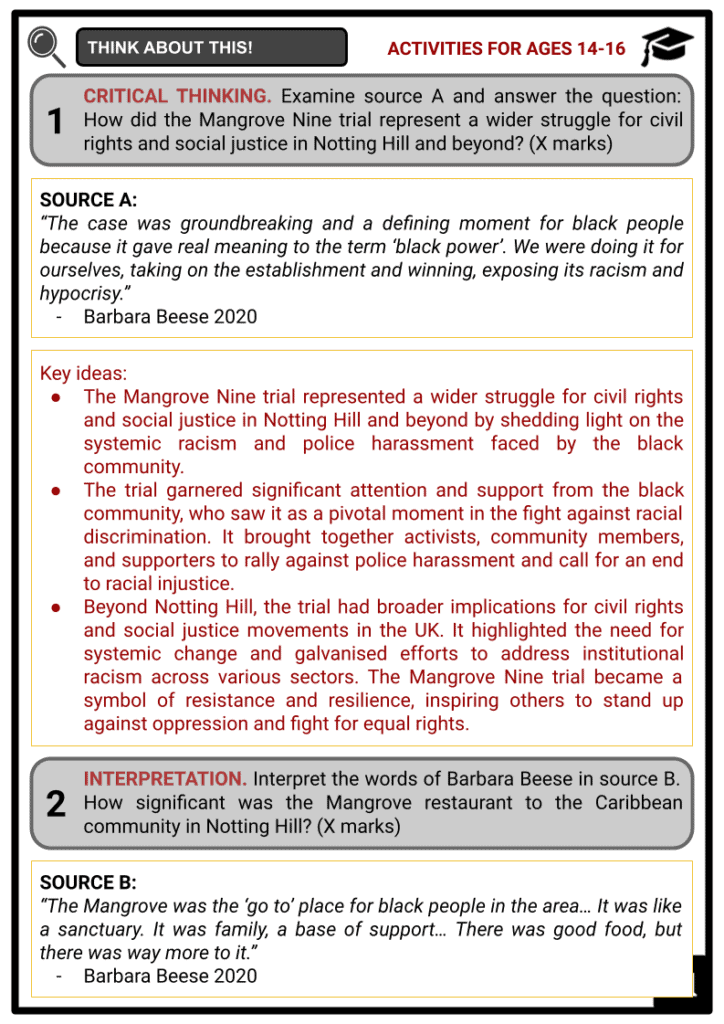Mangrove Nine Worksheets
Do you want to save dozens of hours in time? Get your evenings and weekends back? Be able to teach about the Mangrove Nine to your students?
Our worksheet bundle includes a fact file and printable worksheets and student activities. Perfect for both the classroom and homeschooling!
Summary
- Mangrove Restaurant
- March on Portnall Road
- Trial of Mangrove Nine
- Legacy of Mangrove Nine
Key Facts And Information
Let’s find out more about Mangrove Nine!
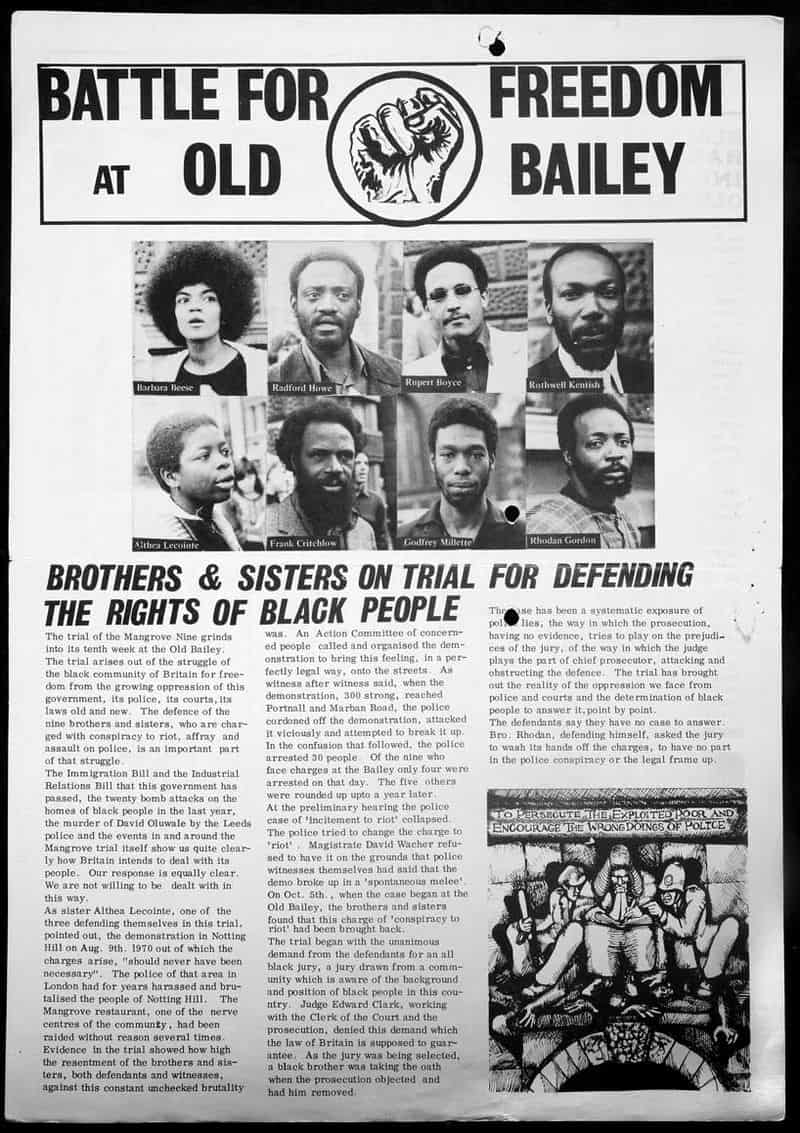
The Mangrove Nine were a group of British Black activists who were tried for inciting a riot at a protest against police targeting the Mangrove, a Caribbean restaurant in Notting Hill, London, in 1970. The trial became a landmark case in the UK, highlighting racial prejudice within the police force and judicial system. It ultimately led to the first judicial acknowledgement of behaviour motivated by racial hatred within the Metropolitan police, marking a pivotal moment in British civil rights history.
The Mangrove Restaurant
- The Mangrove Nine emerged from a climate of racial tension and police discrimination in 1970s Britain.
- The Mangrove restaurant in London's Notting Hill, which was opened by a Trinidadian man named Frank Crichlow in 1968, quickly became a cultural hub for the local Black community, including intellectuals, activists, and artists like Bob Marley, Nina Simone, and Jimi Hendrix.
- The establishment of the restaurant was a direct result of the influx of Caribbean migrants into Britain during the Windrush era. These migrants, named after the HMT Empire Windrush ship that brought one of the first large groups of post-war West Indian immigrants to the UK in 1948, sought to recreate a semblance of their home, resulting in a vibrant and diverse cultural hub.
- The restaurant was more than just an eatery; it was a communal space that embodied the spirit and culture of the Caribbean diaspora in West London. Serving up hearty, traditional Caribbean meals, the restaurant was a home away from home for many individuals.
- Apart from the delicious food, the Mangrove was also a safe space for conversation and friendship, playing a vital role for the local black British community. The intellectual and creative energy within its walls fostered fruitful discussions and contributed significantly to the vibrancy of the local cultural scene.
- However, it also became a target for the local Metropolitan Police, who frequently raided the establishment under the guise of drug searches. Despite no evidence of such illegal activities, the raids were incessant, leading to protests from the community.
- The raids on the Mangrove restaurant were emblematic of the systemic police discrimination faced by the Black community in 1970s Britain. Authorities would storm in unannounced, alleging drug possession and creating an atmosphere of fear and uncertainty. These raids were not only disruptive to the thriving cultural hub but also served as a tool of intimidation, aiming to suppress the vibrant spirit of activism that was taking root in the community.
- They were conducted without sufficient cause or evidence, a reflection of the racial prejudice prevalent within the law enforcement system of the time. The regularity of these raids – supposedly targeted at curbing illicit activities – became a symbol of the constant harassment faced by the black community, which only fuelled their resolve to fight for their rights.
- The incessant and unjustified raids on the Mangrove restaurant sparked outrage among the members of the local community, eventually leading to public demonstrations. The community recognised these raids not as legitimate law enforcement activities, but as racially-motivated intimidation tactics.
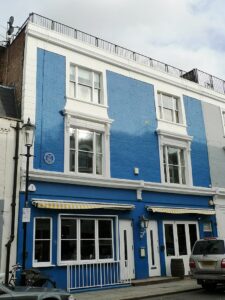
Site of the Mangrove restaurant - In response, they started organising protests to voice their discontent and demand justice. These protests were not just a backlash against police harassment but also an assertion of their civil rights. They rallied together, their unity embodying their collective resistance against the systemic discrimination they faced.
March on Portnall Road
- The Action Committee for the Defence of the Mangrove was a community-led group formed in response to the unfair raids on the Mangrove restaurant. The group proved to be an essential vehicle for mobilising community support and organising the March on Portnall Road.
- On 9th August 1970, around 150 demonstrators took to the streets, marching from the Mangrove restaurant to the local police station. The march was not just a mere assembly of dissatisfied individuals, but a powerful display of collective strength and unity. The protestors took to the streets in a choreographed march, their voices echoing throughout the neighbourhood. They held placards with bold statements like "Hands off Mangrove" and "Black Power", their shared demands resonating with every step they took.
- As the march continued, the atmosphere grew progressively tense. The police presence, initially unobtrusive, soon became a dominating force. Riot gear was donned, and lines of riot police formed a wall against the marchers, their numbers looming ominously over the protestors. The transformation was swift and severe, the show of force by the police serving as a clear message of their intent.
- The onset of the riot was marked by a sudden shift in police tactics. Tear gas canisters were launched into the crowd, creating smoke that filled the streets and caused protestors to cough and have teary eyes. Batons were freely swung, indiscriminately targeting those in their path. The police swept through the crowds, making arrests seemingly without reason or provocation, their actions painting a stark picture of the systemic discrimination the protestors were marching against.
- According to police reports, around 50 individuals were arrested during the protest, including nine individuals that would be later known as the 'Mangrove Nine'. However, this figure has been contested by many protestors who claim the actual number was much higher.
Trial of the Mangrove Nine
- The formation of the 'Mangrove Nine' was a direct outcome of the chaos and violence that marred the March on Portnall Road.
- The nine individuals arrested - Altheia Jones-Lecointe, Barbara Beese, Rupert Boyce, Frank Crichlow, Rhodan Gordon, Darcus Howe, Anthony Innis, Rothwell Kentish, and Godfrey Millett - were charged with incitement to riot. In the eyes of the community, however, these nine people were not criminals but rather symbols of resistance against oppressive law enforcement practices.
- Their arrest and subsequent trial brought national attention to the issue of systemic racism within the justice system, marking a significant chapter in the fight for civil rights in the UK.
- The Mangrove Nine trial took place in the Old Bailey and lasted for a gruelling 55 days. It was presided over by Judge Edward Clarke, who was known for his stern demeanour and strict adherence to legal protocol. His initial indifference to the racial dynamics at play in the trial was met with significant criticism. However, as the trial progressed, he became increasingly open to the defendants' arguments about systemic bias, demonstrating a surprising capacity for change.
- The jury, on the other hand, was a diverse group, a rarity in trials at the time. This was a direct result of the defendants' insistence on a jury that would be representative of their community. The twelve-member jury was made up of ten Caucasians and two black individuals, who deliberated for an unprecedented eight and a half hours before delivering their verdict.
- The defendants decided to represent themselves, a bold move that allowed them to highlight the systemic disparities within the judicial system.
- Their impassioned and articulate defence drew widespread media attention to their cause, turning their individual trial into a platform for addressing broader societal injustices.
- Michael Hill, serving as the prosecutor during the Mangrove Nine trial. His approach to the case, however, has since been widely criticised for reflecting the systemic racial bias prevalent in the UK's legal system at the time. Hill was known for his stern demeanour and dogged pursuit of convictions, often at the expense of fairness and justice.
- As the trial progressed, he found himself increasingly challenged by the articulate and persuasive arguments of the defendants.
- Despite his reputation and experience, Hill was unprepared for the defendants' ability to expose the systemic bias inherent in the legal system, and his case began to unravel under the weight of these revelations.
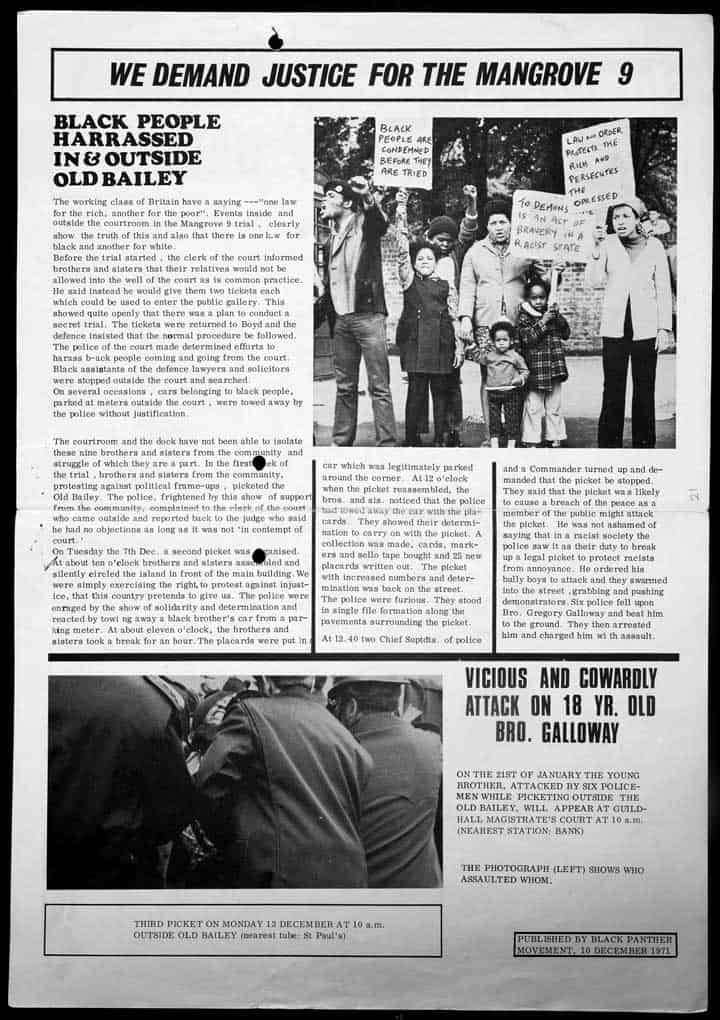
Flyer showing support for Mangrove Nine - Throughout the trial, the defence called 23 witnesses, while the prosecution brought forward 15. Despite the prosecution's extensive efforts to prove incitement to riot, the jury, ultimately did not convict the defendants on the main charge. But perhaps the most significant outcome of the trial was the judge's recognition of evidence of racial hatred within the Metropolitan Police, a rare admission that underscored the culmination of the community's long battle against systemic discrimination.
Legacy
- The Mangrove Nine's courage and tenacity continue to inspire activists today. Their story, now a part of Britain's public consciousness through media portrayals, serves as a powerful reminder of the importance of standing up against systemic racism. Their legacy is a testament to their determination for justice, and it carries a profound impact on the contemporary ‘Black Lives Matter’ movement.
- The 'Black Lives Matter' movement is a global advocacy campaign against systemic racism and violence towards Black people. Originating in the United States in 2013, the movement has since grown into an international movement advocating for the rights of Black individuals around the world. It has brought attention to numerous cases of police brutality, leading to widespread discussions on police reform. The movement continues to fight for racial equality, inspired by the courage of activists like the Mangrove Nine, and plays a vital role in challenging systemic racism today.
- The Mangrove Nine remain an enduring symbol of resistance, highlighting the importance of collective action and the power of the grassroots community in challenging racial injustice. Their story resonates even today, as societies across the globe continue to grapple with the issue of systemic racism.
Image Sources
- https://upload.wikimedia.org/wikipedia/commons/thumb/4/40/Battle_for_Freedom_at_the_Old_Bailey_poster_%2824819736411%29.jpg/800px-Battle_for_Freedom_at_the_Old_Bailey_poster_%2824819736411%29.jpg
- https://upload.wikimedia.org/wikipedia/commons/thumb/4/4c/Rum_Kitchen%2C_Notting_Hill%2C_W11_%2841344046251%29.jpg/800px-Rum_Kitchen%2C_Notting_Hill%2C_W11_%2841344046251%29.jpg
- https://upload.wikimedia.org/wikipedia/commons/f/f2/Mangrove_Nine_flyer_%2824819736331%29.jpg
Frequently Asked Questions
- Who were the Mangrove Nine?
The Mangrove Nine were a group of British Black activists charged with various offences in 1970 following a protest at the Mangrove restaurant in Notting Hill, London.
- What was the outcome of the Mangrove Nine trial?
The Mangrove Nine trial was the first time British Black activists challenged racial discrimination in the criminal justice system. In 1971, the trial ended with the acquittal of all nine defendants on the more serious charges, while some were convicted on lesser charges.
- How did the Mangrove Nine trial impact the civil rights movement in the UK?
The Mangrove Nine trial significantly impacted the civil rights movement in the UK. It brought attention to issues of racial discrimination and police harassment. It led to increased activism in the Black community and greater public awareness and scrutiny of these issues.

